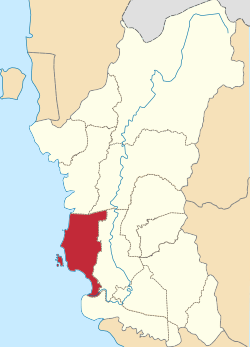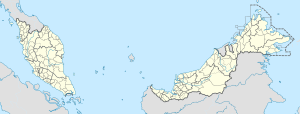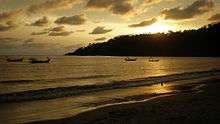Manjung District
The Manjung District is a district in the southwestern part of the state of Perak, Malaysia. The district is well known for its Pangkor Island, a major attraction in Perak and the home of the Royal Malaysian Navy (TLDM) Lumut Naval Base and dockyard. Since the population is increasing, residential and commercial infrastructure is being developed. Dinding was once part of the British Straits Settlements colony.
Manjung District | |
|---|---|
| Daerah Manjung | |
| Other transcription(s) | |
| • Chinese | 曼绒县 |
| • Tamil | மஞ்சோங் |
| • Jawi | منجوڠ |
 Location of Manjung District in Perak | |
 Manjung District Location of Manjung District in Malaysia | |
| Coordinates: 4°20′N 100°40′E | |
| Country | |
| State | |
| Seat | Seri Manjung |
| Largest town | Sitiawan |
| Local area government(s) | Manjung Municipal Council |
| Government | |
| • District officer | Fariz Hanip[1] |
| Area | |
| • Total | 1,113.58 km2 (429.96 sq mi) |
| Population (2010)[3] | |
| • Total | 224,331 |
| • Estimate (2015)[4] | 249,600 |
| • Density | 200/km2 (520/sq mi) |
| Time zone | UTC+8 (MST) |
| • Summer (DST) | UTC+8 (Not observed) |
| Postcode | 320xx-325xx, 327xx, 349xx |
| Calling code | +6-05 |
| Vehicle registration plates | A |
Seri Manjung is the district's principal urban centre while smaller towns include Lumut town, Sitiawan town, Ayer Tawar, Pantai Remis and Beruas.
History
.jpg)
Prior to 1973 the district was called Dindings. It used to be part of the Straits Settlements then under the administration of Penang. Dindings district became part of the Pangkor Engagement (also commonly known as the Pangkor Treaty), signed by Britain and the British appointed Sultan of Perak, Sultan Abdullah, in January 1874. This agreement was signed to stop bloodshed resulting from two major events, the struggle for the throne between relatives of Perak royalty upon the death of Sultan Ali and Chinese clan wars between Ghee Hin and Hai San to grab tin mining areas in Late Colonial Taiping.
The agreement required the Sultan of Perak to surrender Dindings to the British, to accept a British Resident, Sir JWW Birch, and the appointment of Assistant Resident in Taiping, Captain Tristram Speedy. Sultan Ismail was to step down from the throne of Perak.
During the British colonial era, Colonial Dindings comprised three main areas: Sitiawan, Lumut and Pangkor Island.
In 1937, the Sultan of Perak, Sultan Iskandar Alang successfully appealed to the British for the return of Dindings to Perak. The Perak Government united the former colony with Bruas and coastal areas to the south, forming the Dindings district. In 1973, Dindings district was given the current name Manjung.
On 24 April 2009, Lumut was declared by the Sultan Perak as the Royal Malaysian Navy's Town – or simply called as TLDM Town or Navy Town. Manjung also was declared as "Bandar Pelancongan Dan Maritim" (Tourism and Maritime Town) by government of Perak.
In August 2016, Sembilan Island was separated from Manjung District and incorporated into Bagan Datuk District.[5]
Administrative divisions

Demographics
The following is based on Department of Statistics Malaysia 2010 census.[3]
| Ethnic groups in Manjung, 2015 census | ||
|---|---|---|
| Ethnicity | Population | Percentage |
| Bumiputera | 116,006 | 50.3% |
| Chinese | 83,500 | 36.1% |
| Indian | 31,257 | 13.5% |
| Others | 509 | 0.2% |
| Total | 230,763 | 100% |
Federal Parliament and State Assembly Seats
List of Manjung district representatives in the Federal Parliament (Dewan Rakyat)
| Parliament | Seat Name | Member of Parliament | Party |
|---|---|---|---|
| P68 | Beruas | Ngeh Koo Ham | Pakatan Harapan (DAP) |
| P74 | Lumut | Mohd Hatta Ramli | Pakatan Harapan (AMANAH) |
List of Manjung district representatives in the State Legislative Assembly of Perak
| Parliament | State | Seat Name | State Assemblyman | Party |
|---|---|---|---|---|
| P68 | N36 | Pengkalan Baharu | Abd Manaf Hashim | Perikatan Nasional (BN-UMNO) |
| P68 | N37 | Pantai Remis | Wong May Ing | Pakatan Harapan (DAP) |
| P68 | N38 | Astaka | Teoh Yee Chern | Pakatan Harapan (DAP) |
| P74 | N51 | Pasir Panjang | Yahaya Mat Nor | Pakatan Harapan (AMANAH) |
| P74 | N52 | Pangkor | Zambry Abdul Kadir | Perikatan Nasional (BN-UMNO) |
Education
Manjung also has numerous schools along with its rapid population growth. There are 24 Chinese primary schools and five Chinese secondary schools in the district. Of these, five schools were founded by Ong Seok Kim.[7] They are SJK (C) Chung Cheng,[8] Sitiawan in 1920; SMJK Nan Hwa[9] (which split into Sekolah Tinggi Nan Hwa, Ayer Tawar Road in 1984) in 1935; SJK (C) Ping Min,[10] Lumut in 1951; and SMJK Dindings,[11] Lumut in 1953. Ong Seok Kim died in 1964. The following year, the Manjung community established the Ong Seok Kim Memorial Education Fund in his honour. The fund offers scholarships and loans to students in the Manjung District, irrespective of ethnicity.[12] All school are under the administration of Pejabat Pendidikan Daerah Manjung.
Secondary education
- SMK Seri Manjung
- SMK Kampung Dato’ Seri Kamaruddin
- SMK Ahmad Boestamam
- SMK Convent, Sitiawan
- SMK Methodist (ACS), Sitiawan
- SMK Tok Perdana
- SMK Ambrose
- SMK Methodist, Ayer Tawar
- SMK Raja Shahriman
- SMK Pantai Remis
- SMK Changkat Beruas
- SMK Dato' Idris, Pengkalan Bharu
- SMK Seri Samudera
- SMK Batu Sepuluh, Lekir
- SMK Pangkalan TLDM
- SMK Pangkor
- Kolej Vokasional Seri Manjung
Tertiary education
- Universiti Kuala Lumpur Malaysian Institute of Marine Engineering Technology (UniKL MIMET)
- Institut Kemahiran Mara (IKM) (Lumut)
- Kolej Komuniti (located partly in Sekolah Teknik Seri Manjung)
- Kolej Kejururawatan Ipoh (Lumut branch – located near in Lumut Town)
Transport
The public transportation servicing the Manjung area are public buses that one could board at either Stesen Bas Seri Manjung and Stesen Bas Lumut.
Other forms of transportation include taxis and rental cars.
Manjung district is also accessible via Route 5, Route 60 , Ipoh-Lumut highway and West Coast Expressway.
Healthcare
The main healthcare centres in Manjung are:
- Hospital Seri Manjung, Seri Manjung
- Hospital Angkatan Tentera, Lumut
- Sri Manjung Specialist Centre ( member of KPJ Healthcare Berhad Group)
- Klinik Kesihatan Sitiawan, Sitiawan
- Klinik Kesihatan Ayer Tawar, Ayer Tawar
- Klinik Kesihatan Pulau Pangkor, P. Pangkor
- Klinik Kesihatan Pantai Remis, Pantai Remis
- Klinik Kesihatan Beruas, Beruas
- Klinik Kesihatan Lekir, Lekir, Sitiawan
- Pantai Hospital Seri Manjung (opened April 2014)
- Columbia Asia Hospital, Sitiawan, to replace the earlier proposed Goodhope Specialist Hospital, Sitiawan (abandoned, January 2014)
- More than 70 private clinics (family physicians)
Economy
The major economic sectors in Manjung are agriculture, manufacturing and the services industries. Agriculture is the main economic sector, making up the majority of the population's employment. Manjung is well known for its livestock production, especially poultry. Sea fishing and fish/prawn farming are the most important economic activities for some community members. At least 5,000 residents are fishermen. Farming of fresh-water fish and prawns are being carried out thoroughly in the district. There are more than 300 ponds of prawns in operation. The most popular prawn farming area is along Dinding River.
Manjung District has become the fastest growing district in the state of Perak. Property prices are seeing increases of over 15% in the past few years. In terms of growth of commercial sector, Manjung is the second fastest growing district in the state, with 5,947 developed units or 13.32%.[15] Many of these businesses and industries are located along the roads connecting Sitiawan, Seri Manjung, Lumut and Ayer Tawar. Industrial and commercial activities are also present in other smaller, neighboring towns such as Beruas, Pantai Remis, Pekan Gurney, Lekir and Changkat Kuring.
Businesses in Manjung include wholesale, groceries and services. There are also informal activities such as settled hawkers (1,029 which cover 11.00%) and itinerant hawkers (1,092 which cover 11.00%) in Manjung district.
Of all the business activities here, services contribute about 72.30% of all the commercial activities. The groceries sector is the second largest commercial activity, covering 24.40% (1,449 unit), while wholesale activities cover the remaining portion, with about 3.40%.
Tourism
Pangkor

Pangkor Island, a holiday resort, is one of the most well known islands in Malaysia. It is located approximately 90 km southwest of Ipoh. The main tourist drawer to Pangkor Island are beaches on the western coastline, such as Pantai Puteri Dewi, Pasir Bogak Beach, Teluk Belanga, Teluk Segadas, Teluk Nipah, and Teluk Cempedak.
The main island of Pangkor is populated mainly by fisherfolk who occupy the eastern coastline. The island is famous for its anchovies and squid.
There are also ruins of a 330-year-old Dutch fort which was one of the Dutch strongholds against pirates and local Malays. Another historical interest on Pangkor Island is the Pangkor Stone Tablet (Batu Bersurat Pangkor in Malay) which is near the Dutch fort.
Pangkor Laut Island, a small privately owned island to the southwest of the main island, is the second largest of the nine islands that make up the Pangkor archipelago. Pangkor Laut is known for its white beaches and crystal clear waters. It has three main beaches, Emerald Bay, Coral Beach and Royal Bay.
Marina Island
Marina Island[16] is one of the man-made island in Malaysia, built on the coast of Teluk Muruh, opposite Pangkor Island and Pangkor Laut Resort, in the state of Perak, Malaysia. The island covers an area of 316.9 acres located 400 meters from the mainland's shoreline. Marina Island took five years of methodical planning and exhaustive feasibility studies to ensure that the making of the island would not disrupt the environment.
Marina Island is also a gateway to Pangkor Island with the establishment of a domestic jetty terminal in the island. The journey to Pangkor Island takes only 10 minutes from the Marina Island Jetty.
Beaches

Aside from beaches on Pangkor Island, there are other beaches in Manjung that are popular among locals and tourists. Teluk Batik is often a favourite choice for campers, picnickers, swimmers and sun-lovers. Those who prefer privacy should visit the tranquil Teluk Rubiah, a beach surrounded by verdant hills and accessible only via a single entrance. Other notable beaches in the area are Pasir Panjang Beach and Teluk Senangin.
Other places of interest
The Terrapin Breeding Centre is a breeding centre for terrapins (or Batagur baska) as well as an information centre for wildlife enthusiasts.
Museums in the district are Beruas Museum and Sitiawan Settlement Museum.
Golf courses
A few popular golf courses in Manjung are Damai Laut Golf and Country Club.
Shopping Centres
- Billion Shopping Centre, Jalan Lumut, Seri Manjung
- The Store,[17] Sitiawan (formerly Fajar Supermarket)
- Rapid Supermarket, Sri Manjung (formerly Ceria Supermarket)
- Econsave[18] Hypermarket, Sitiawan
- Tesco Hypermarket, Seri Manjung
- AEON Seri Manjung
- Mydin Hypermarket, Sri Manjung (proposed) – beside Toyota Showroom
- TF Value, Seri Manjung
Stadiums
- Mini Stadium Seri Manjung
- Padang Astaka Sitiawan
- MP3 Badminton Court Centre (located near giant hypermarket)
References
- "Portal Rasmi Pejabat Daerah Dan Tanah - Pegawai Daerah". pdtmanjung.perak.gov.my.
- "Rancangan Struktur Negeri Perak 2040" (PDF). Archived from the original (PDF) on 2018-03-28. Retrieved 2018-03-28.
- "Population Distribution and Basic Demographic Characteristics, 2010" (PDF). Department of Statistics, Malaysia. Archived from the original (PDF) on 22 May 2014. Retrieved 19 April 2012.
- "Rancangan Struktur Negeri Perak 2040" (PDF). p. 316. Archived from the original (PDF) on 2018-03-28. Retrieved 2018-03-28.
- SAID, MOHAMAD HAFIZI MOHD. "Pulau Sembilan kini bawah Bagan Datoh". Retrieved 8 November 2016.
- "Portal Rasmi Pejabat Daerah Dan Tanah - Profil Daerah". pdtmanjung.perak.gov.my.
- Wang Jianshi, Ong Eng-Joo: No Other Way Out – A Biography of Ong Seok Kim. Petaling Jaya, Malaysia: Strategic Information and Research Development Centre, 2013, see Official Site of Ong Seok Kim
- "Chung Cheng Primary School, Sitiawan - Ong Seok Kim". ongseokkim.com.
- "Nan Hwa High School, Sitiawan - Ong Seok Kim". ongseokkim.com.
- "Ping Min Free School, Pundut, Lumut - Ong Seok Kim". ongseokkim.com.
- "50LKC_4020_edited-1 - Ong Seok Kim". ongseokkim.com.
- "Ong Seok Kim Memorial Education Fund – Ong Seok Kim". Retrieved 8 November 2016.
- Outward Bound Malaysia
- "Pusat Latihan Khidmat Negara". Archived from the original on 2014-02-01. Retrieved 2014-01-30.
- Malaysian, Digest. "Malaysian Digest". malaysiandigest.com. Retrieved 26 September 2015.
- "Marina Island Pangkor - An Integrated Man-made World". Marina Island - Pangkor.
- "The Store Corporation Berhad - Operator of Supermarkets - Departmental Stores - Hypermarkets". www.tstore.com.my.
- Econsave